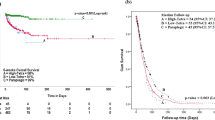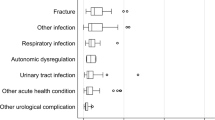Abstract
Study design
Descriptive retrospective.
Objectives
To evaluate the burden of respiratory morbidity in terms of ventilator dependence (VD) days and length of stay in neurotrauma ICU (NICU) and hospital, and to determine mortality in patients with traumatic cervical spinal cord injury (CSCI) in a low middle-income country (LMIC).
Setting
Jai Prakash Narayan Apex Trauma Center (JPNATC), All India Institute of Medical Sciences (AIIMS), New Delhi, India.
Methods
A total of 135 patients admitted with CSCI in the NICU between January 2017 to December 2018 were screened. Information regarding age, gender, American Spinal Injury Association (ASIA) impairment scale (AIS), level of injury, duration of VD, length of NICU, hospital stay, and outcome in terms of mortality or discharge from the hospital were obtained from the medical records.
Results
A total of 106 CSCI patients were analyzed. The mean (SD) age of patients was 40 (±16) years and male: female ratio was 5:1. The duration of VD, duration of NICU, and hospital stay was a median of 8 days (IQR 1127), 6 days (IQR 1118), and 15 days (IQR 3127) respectively. Mortality was 19% (20/106). The mortality was significantly associated with poorer AIS score, VD, and duration of ICU and hospital stay. All patients were discharged to home only after they became ventilator-free.
Conclusions
The ventilator burden, hospital stay, and mortality are high in patients with CSCI in LMICs. Poor AIS scores, prolonged VD, ICU and hospital stay are associated with mortality. There is a need for comprehensive CSCI rehabilitation programs in LMICs to improve outcome.
Similar content being viewed by others
Log in or create a free account to read this content
Gain free access to this article, as well as selected content from this journal and more on nature.com
or
Data availability
The datasets generated and/or analyzed during the current study are available from the corresponding author on reasonable request.
References
Mock C, Joshipura M, Arreola-Risa C, Quansah R. An estimate of the number of lives that could be saved through improvements in trauma care globally. World J Surg. 2012;36:959–63.
Singh R, Dhankar SS, Rohilla R. Quality of life of people with spinal cord injury in Northern India. Int J Rehabil Res. 2008;31:247–51.
Spiegel DA, Gosselin RA, Coughlin RR, Joshipura M, Browner BD, Dormans JP. The burden of musculoskeletal injury in low and middle-income countries: Challenges and opportunities. J Bone Jt Surg - Ser A. 2008;90:915–23.
Parent S, Barchi S, LeBreton M, Casha S, Fehlings MG. The impact of specialized centers of care for spinal cord injury on length of stay, complications, and mortality: a systematic review of the literature. J Neurotrauma. 2011;28:1363–70. https://doi.org/10.1089/neu.2009.1151
Chhabra HS, Sharma S, Arora M. Challenges in comprehensive management of spinal cord injury in India and in the Asian Spinal Cord network region: findings of a survey of experts, patients and consumers. Spinal Cord. 2018;10:71–7.
Galvagno SM, Nahmias JT, Young DA. Advanced trauma life support® Update 2019: management and applications for adults and special populations. Anesthesiol Clin. 2019;37:13–32.
Füssenich W, Hirschfeld Araujo S, Kowald B, Hosman A, Auerswald M, Thietje R. Discontinuous ventilator weaning of patients with acute SCI. Spinal Cord. 2018;56:461–8.
Galeiras Vázquez R, Rascado Sedes P, Mourelo Fariña M, Montoto Marqués A, Ferreiro Velasco ME. Respiratory management in the patient with spinal cord injury. BioMed Res Int. 2013. https://doi.org/10.1155/2013/168757
Lalwani S, Singh V, Trikha V, Sharma V, Kumar S, Bagla R, et al. Mortality profile of patients with traumatic spinal injuries at a level I trauma care center in India. Indian J Med Res. 2014;140:40–45.
Aleem IS, DeMarco D, Drew B, Sancheti P, Shetty V, Dhillon M, et al. The burden of spine fractures in India: a prospective multicenter study. Glob Spine J. 2017;7:325–33.
Loss SH, De Oliveira RP, Maccari JG, Savi A, Boniatti MM, Hetzel MP, et al. The reality of patients requiring prolonged mechanical ventilation: a multicenter study. Rev Bras Ter Intensiv. 2015;27:26–35.
Berlowitz DJ, Wadsworth B, Ross J. Respiratory problems and management in people with spinal cord injury. Breathe. 2016;12:328–40.
Soni KD, Kaushik G, Gupta A, Singh V, Kumar S, Sagar S. From emergency department to intensive care unit, does the delay matter to trauma patients? J Emerg Trauma Shock. 2018;11:189–92. https://doi.org/10.4103/JETS.JETS_132_17
Gupta D, Sharma D, Kannan N, Prapruettham S, Mock C, Wang J, et al. Guideline adherence and outcomes in severe adult traumatic brain injury for the CHIRAG (collaborative head injury and guidelines) study. World Neurosurg. 2016;89:169–79. https://doi.org/10.1016/j.wneu.2015.12.097
Wang HC, Chen KY, Lin YT, et al. Factors associated with prolonged mechanical ventilation and reventilation in acute cervical spinal cord injury patients. Spine. 2020;45:E515–E524. https://doi.org/10.1097/brs.0000000000003302
Bank M, Gibbs K, Sison C, Kutub N, Papatheodorou A, Lee S, et al. Age and other risk factors influencing long-term mortality in patients with traumatic cervical spine fracture. Geriatr Orthop Surg Rehab. 2018;9:2151459318770882 https://doi.org/10.1177/2151459318770882
Franceschini M, Bonavita J, Cecconi L, et al. Traumatic spinal cord injury in Italy 20 years later: current epidemiological trend and early predictors of rehabilitation outcome. Spinal Cord. 2020;58:768–777. https://doi.org/10.1038/s41393-020-0421-y
Pickett GE, Campos-Benitez M, Keller JL, Duggal N. Epidemiology of traumatic spinal cord injury in Canada. Spine (Philos Pa 1976). 2006;31:799–805. https://doi.org/10.1097/01.brs.0000207258.80129.03
Liebscher T, Niedeggen A, Estel B, Seidl RO. Airway complications in traumatic lower cervical spinal cord injury: a retrospective study. J Spinal Cord Med. 2015;38:607–14.
Conradsson D, Phillips J, Nizeyimana E, Hilliar C, Joseph C. Risk indicators of length of acute hospital stay after traumatic spinal cord injury in South Africa: a prospective, population-based study. Spinal Cord. 2019;57:763–9. https://doi.org/10.1038/s41393-019-0286-0
Zheng Y, Mao YR, Yuan TF, Xu DS, Cheng LM. Multimodal treatment for spinal cord injury: a sword of neuroregeneration upon neuromodulation. Neural Regen Res. 2020;15:1437–50. https://doi.org/10.4103/1673-5374.274332
Øderud T. Surviving spinal cord injury in low income countries. Afr J Disabil. 2014;3:80 https://doi.org/10.4102/ajod.v3i2.80
Neumann CR, Brasil AV, Albers F. Risk factors for mortality in traumatic cervical spinal cord injury: Brazilian data. Crit Care. 2009;67:67–70.
Higashi T, Eguchi H, Wakayama Y, Sumi M, Saito T. Risk factors associated with mortality after traumatic cervical spinal cord injury. OTA Int. 2018;1:e003.
Chamberlain JD, Meier S, Mader L, Von Groote PM, Brinkhof MWG. Mortality and longevity after a spinal cord injury: Systematic review and meta-analysis. Neuroepidemiology 2015;44:182–98.
Shao J, Zhu W, Chen X, et al. Factors associated with early mortality after cervical spinal cord injury. J Spinal Cord Med. 2011;34:555–62. https://doi.org/10.1179/2045772311Y.0000000024
Shavelle RM, DeVivo MJ, Strauss DJ, Paculdo DR, Lammertse DP, Day SM. Long-term survival of persons ventilator dependent after spinal cord injury. J Spinal Cord Med. 2006;29:511–9. https://doi.org/10.1080/10790268.2006.11753901.
Zakrasek EC, Nielson JL, Kosarchuk JJ, Crew JD, Ferguson AR, McKenna SL. Pulmonary outcomes following specialized respiratory management for acute cervical spinal cord injury: a retrospective analysis. Spinal Cord. 2017;55:559–65. https://doi.org/10.1038/sc.2017.10
Rinkaewkan P, Kuptniratsaikul V. The effectiveness of inpatients rehabilitation for spinal cord patients in Siriraj hospital. Spinal Cord. 2015;53:591–7. https://doi.org/10.1038/sc.2015.8
Renaud R, Locke H, Hariharan R, Chamberlain M, O’Connor R. Developing a spinal cord injury rehabilitation service in Madagascar. J Rehabilitation Med. 2018;50:402–5.
Author information
Authors and Affiliations
Contributions
DS: Designing, screening the records, Data collection, and report writing. AB: Designing, Data collection, analyzing the data and writing. KG: Designing and writing. NK: Designing and writing. PKS: Contributed to designing of the retrospective analysis, analyzing the results and making the report. AC: Contributed to designing of the retrospective analysis, analyzing the results and making the report. RM: Contributed to designing of the retrospective analysis, analyzing the results and making the report. AM: Contributed to data interpretation and Statistical analysis.
Corresponding author
Ethics declarations
Conflict of interest
The authors declare no competing interests.
Ethical approval
The study was approved by the Institute Ethics Committee, All India Institute of Medical Sciences, New Delhi, India via letter no IEC-101/01.02.2019, RP – 20/2019.
Additional information
Publisher’s note Springer Nature remains neutral with regard to jurisdictional claims in published maps and institutional affiliations.
Rights and permissions
About this article
Cite this article
Sengupta, D., Bindra, A., Kumar, N. et al. Respiratory morbidity and mortality of traumatic cervical spinal cord injury at a level I trauma center in India. Spinal Cord Ser Cases 7, 36 (2021). https://doi.org/10.1038/s41394-020-00371-5
Received:
Revised:
Accepted:
Published:
DOI: https://doi.org/10.1038/s41394-020-00371-5



